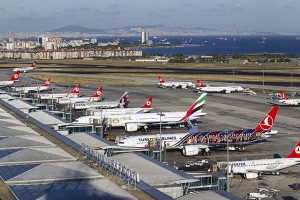 While advanced economies are in recovery mode, the slowdown in emerging markets is putting the brakes on the global airfreight momentum that began last year, prompting predictions of limited growth for the airfreight industry in the second half of this year.
While advanced economies are in recovery mode, the slowdown in emerging markets is putting the brakes on the global airfreight momentum that began last year, prompting predictions of limited growth for the airfreight industry in the second half of this year.
Airports Council International (ACI) in its latest analysis says growth in the first half of the year has become more subdued in line with weaker global demand for foreign goods and commodities compared to 2014.
“Business confidence was in limbo for the first half of 2015 and this is reflected in a weakening of orders by air and the build-up of inventories,” ACI said.
Thus, airfreight markets expanded by only 3.4% in the first half of 2015 compared to the same period the previous year.
ACI adds that expansion prospects in the latter half of 2015 “will remain limited” despite an optimistic outlook for future global economic growth. This is because two forces are at work in pushing the pendulum in opposite directions, it said. Key regional economies such as North America have started to get back on course, boosting the global economy, but a cyclical slowdown in emerging markets is dampening the potential for significant advances in the global airfreight market.
Regional performance
On a regional basis, the Asia-Pacific airfreight market has been “enfeebled” in the first half of the year by weakening of international trade activity. Overall growth in volumes has slowed to 3% on a year-to-date basis. The cross-border shipment of goods shows the weakest growth.
International freight volumes, which make up the greatest proportion of traffic in the region, grew by only 2.7% for the first six months of 2015, whereas domestic freight traffic grew by 3.8%. The top global airfreight hub, Hong Kong, had an increase of only 0.6% in traffic for the first half of 2015. Shanghai and Incheon, the region’s second and third busiest airfreight hubs, had year-over-year increases of 5% and 1.5%, respectively.
In contrast, North America posted growth of 4.8% year-over-year in the first half of 2015. The higher growth in North America continues to coincide with an American rebound. “Strong economic fundamentals helped propel the airfreight market,” said ACI. “For a mature market, the relatively high level of growth in airfreight volumes represents a banner year, at least with respect to the first half of 2015.”
Regional growth is exceeding 2013 levels. Although Memphis increased by only 0.6%, other airports in the region achieved significant strides in year-over-year increases in volumes. With the investment in the airport’s Northeast Cargo Center, the biggest gains were achieved by Chicago O’Hare with volumes moving up by 20.5% in the first half of 2015.
Another region that has had a good first half is the Middle East, posting the greatest increase in accumulated volumes as compared to other regions at 8.6% year-over-year. Dubai International Airport, the region’s largest freight hub, grew by 2.8% over the same period, while other airports posted significantly increased volumes. Both Doha and Dubai World Central (DWC), the second and third ranked airports, grew by 11.4% and 57.6%, respectively. With capacity for 12 million metric tons of airfreight, DWC is now set to be the region’s future air cargo hub, experiencing significant growth following the start of operations.
The economic bloc of Europe, meanwhile, had a sluggish air cargo market in the first six months of the year. Volumes inched up by just 0.5% during the period as the uncertainty regarding the Greek debt crisis and its potential contagion effects keeps rising business confidence in check. Ongoing geopolitical concerns in Eastern Europe may also represent a potential obstacle for the European airfreight market. The region’s three major hubs Frankfurt, Paris, and Amsterdam experienced declines of 2.3%, 4.7% and 2.1%, respectively, in the reviewed period.
Growth in Latin America-Caribbean volumes has remained weak as the Brazilian and Argentinian economies continue to struggle. The region saw a modest rise in traffic of 1% year-over-year over the first two quarters of 2015. Growth patterns continue to be mixed for Latin America-Caribbean as a whole. While major Brazilian airports such as Sao Paulo-Guarulhos and Campinas—which occupy a large share of the region’s freight volumes—experienced a decline of 1.2% and 11.4%, respectively, in airfreight volumes, other airports have achieved significant advances. El Dorado, a Colombian airport and the region’s leading airfreight hub, experienced a gain of 6% in traffic in the first half of 2015. Mexico saw a double-digit rise of 15.6% fueled by a burgeoning international freight market.
Meantime, the African airfreight market grew by 7.4% in the first half of 2015. While results are mixed across the continent, Johannesburg, a leading airfreight hub, has bounced back after a bleak 2014. Accumulated volumes from January to June 2015 grew by 11.7% as compared to the same period in the previous year. Cairo, the continent’s busiest air cargo hub, and Johannesburg occupy over 30% of the continent’s traffic.
Photo: Ercan Karakas





